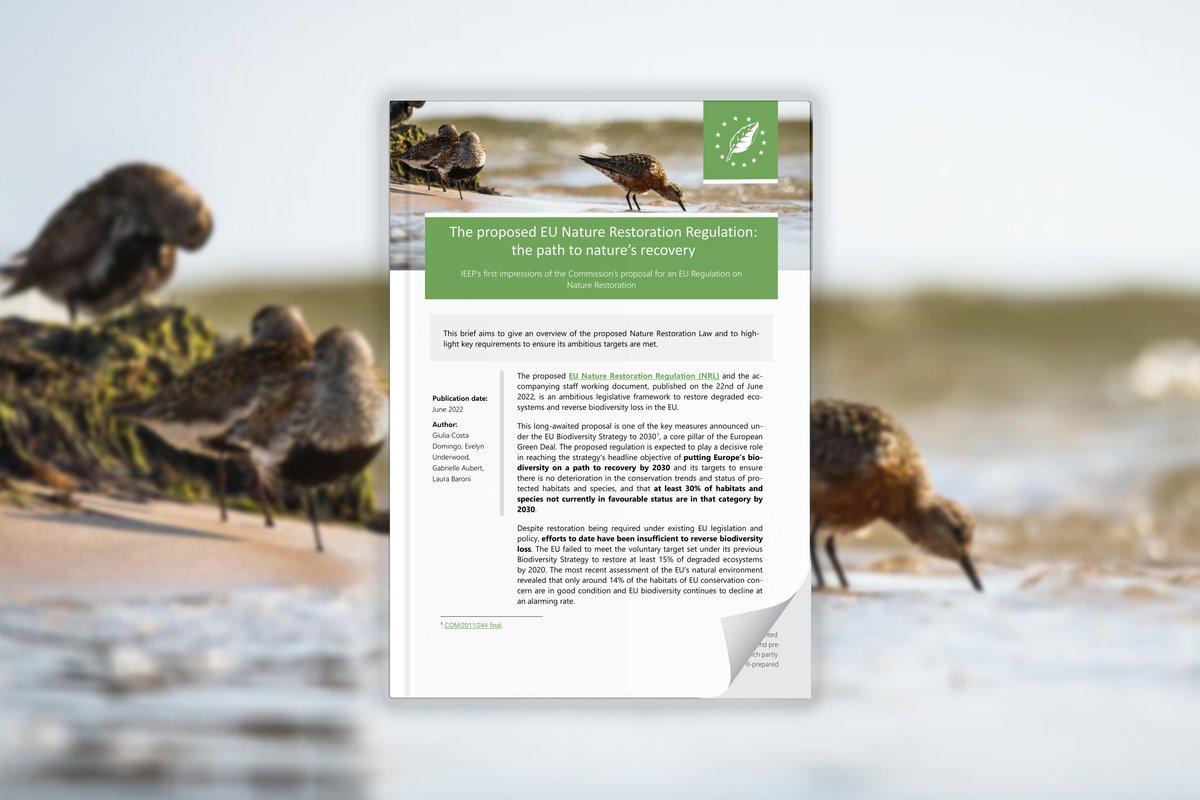AUTHORS: Giulia Costa Domingo – Evelyn Underwood – Gabrielle Aubert – Laura Baroni
After several delays, the highly anticipated proposal for an EU law on nature restoration is now out. The adoption of this proposal would mark a historic turning point for EU nature conservation. As it enters the EU legislative process, this is a critical moment to ensure its ambition remains high and that its key components are not watered down.
In this new brief, IEEP gives an initial overview of the proposal and highlights key requirements to ensure its targets are met.
The proposed EU Nature Restoration Regulation, published today, is an ambitious legislative framework to restore degraded ecosystems in the EU. It is one of the key measures announced under the EU Biodiversity Strategy to 2030 and is expected to play a decisive role in reaching the Strategy’s headline objective of putting Europe’s biodiversity on a path to recovery by 2030.
Despite restoration being required under existing EU legislation, efforts to date have been insufficient to reverse biodiversity loss. The EU failed to meet its voluntary target to restore at least 15% of degraded ecosystems by 2020. Alarmingly, the EU’s latest assessment revealed that only around 14% of habitats are in good condition and that biodiversity continues to rapidly decline.
The need to strengthen action on nature restoration has been recognised by the European Commission, the European Parliament, and the Council. Momentum has also been building at the international stage with 2021-2030 being proclaimed as the UN Decade for ecosystem restoration. A new global target to place at least 20% of degraded ecosystems under restoration by 2030 is being discussed as part of the post-2020 global biodiversity framework.
The restoration law aims to contribute to the continuous, long-term, and sustained recovery of EU habitats and species across land and sea. It sets an overarching objective, in line with the proposed international target, to implement restoration measures on at least 20% of the EU’s territory by 2030. The proposal calls for the prioritisation of restoring habitats to maximise biodiversity benefits alongside co-benefits for other key challenges such as climate mitigation and hazard risk prevention.
The adoption of this proposal could represent a watershed moment for EU biodiversity. The regulation would be the first new EU legislative instrument on nature preservation since the EU Habitats Directive came into force in 1992, and the first ever legal requirement for large-scale nature restoration. We, from decision-makers to civil society, must ensure that this unique opportunity to strengthen the EU’s legislative framework on nature restoration is effectively used to turn the tide on biodiversity loss.
This will require:
- Ambitious targets which strengthen and go beyond existing EU legislation
To achieve the proposal’s objectives, ambitious, specific, measurable, urgent, and time-bound targets are crucial. The proposal sets out an overarching legally binding objective for ecosystem restoration as well as ecosystem-specific targets which strengthen and go beyond current EU nature restoration legislation. These targets are set for 2050 with binding milestones by 2030 and 2040.
- Strong communication and understanding of the huge environmental, societal and economic benefits which these restoration targets will deliver
Highlighting the many benefits of nature restoration is key to ensuring the restoration targets are supported and embraced by all stakeholders and society at large. Healthy ecosystems and the services they deliver underpin societal wellbeing and prosperity. Restoring nature is therefore crucial to tackling many of the sustainability challenges we currently face from climate change to food security and the mental health crisis. Moreover, nature restoration can promote healthy lifestyles and social benefits while increasing the resilience of economic sectors and creating new economic opportunities and jobs. Through its co-benefits, the nature restoration law will help Member States meet other existing and upcoming targets and obligations under the EU Green Deal and international commitments.
- A strong implementation framework through carefully designed National Restoration Plans
Strategic prioritisation and planning are needed for planning, financing, implementation, and monitoring of restoration action. This will be done through National Restoration Plans which will lay out how Member States will achieve the targets and obligations of the according to their specific national needs and context. Member States are expected to submit a first draft of these plans within 2 years of the entry into force of the regulation and the plans will run until 2050. A key element of the plans will be to outline the financing needs for implementing the plan. The Commission will assess these plans to ensure they adequately meet the requirements of the law.
- Effective monitoring and reporting
Effective monitoring and reporting are needed to ensure that planned restoration measures are implemented and are delivering their expected biodiversity restoration benefits on the ground. Progress towards the objectives will be monitored and reported by Member States and EU-wide reports will be prepared based on this. The regulation will be reviewed in 2035 to determine whether the law is achieving its objectives. Through strengthened monitoring, the proposed restoration law also presents an important opportunity to increase our knowledge and strengthen monitoring of EU ecosystems and services.
Read more about the nature restoration law proposal and its key components in our brief.
We will be discussing the nature restoration law proposal during the Think2030 conference, co-organised by IEEP and IDDRI. Together with experts and policy makers, we will explore its opportunities and challenges and refine policy recommendations to ensure the successful implementation of the law once adopted.


